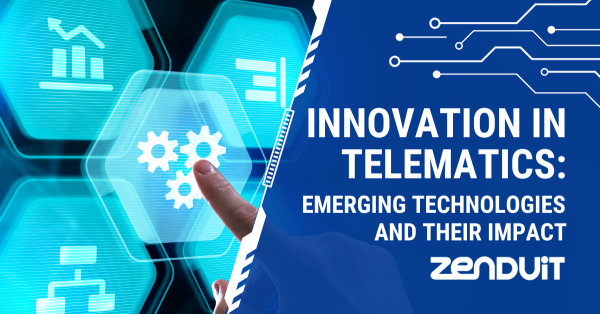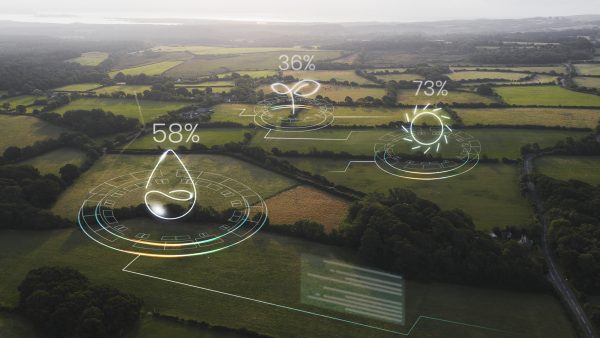
Telematics has become increasingly significant in modern industries due to its wide range of applications and benefits. In 2023, market size is projected to grow from USD 43.71 billion to USD 70.55 billion by 2028, at a compound annual growth rate (CAGR) of 10.05%.
This substantial growth highlights the critical role of telematics in enhancing operational efficiency, safety, and cost-effectiveness across various sectors, particularly in transportation, logistics, and automotive industries.
By integrating advanced telecommunications with information technology, telematics has revolutionized how industries manage and operate their vehicle fleets, offering real-time data analytics, improved asset utilization, and enhanced customer experiences.
This article aims to explore the cutting-edge innovations in telematics and analyze the impact of these emerging technologies on various industries. We will explore the latest advancements, examine how they are reshaping the landscape of telematics, and discuss their implications for the future.
The Evolution of Telematics Technology
This technology originated from the blend of telecommunications and informatics. Its evolution began with the simple use of telecommunication devices in vehicles for tracking and navigation purposes.
Over the years, the technology has grown to incorporate more complex systems like GPS navigation, automated emergency calls (eCall), and wireless safety communications. The integration of Internet connectivity and smartphone technology further expanded the capabilities of telematics, allowing for real-time data transmission, analytics, and remote vehicle control.
Key Milestones in the Development of Telematics
- 1970s-1980s: The inception of telematics can be traced back to the use of GPS and cellular technology in vehicles.
- 1990s: The introduction of the General Packet Radio Service (GPRS) enabled faster data transmission, enhancing vehicle tracking and fleet management.
- Early 2000s: The advent of 3G and later 4G networks significantly improved connectivity, leading to the development of more sophisticated applications like real-time monitoring and diagnostics.
- 2010s: The emergence of IoT (Internet of Things) and cloud computing further revolutionized telematics, enabling more integrated, efficient, and scalable systems.
Previous Challenges and Breakthroughs
Early challenges in the field of telematics included limited network coverage, slow data transmission speeds, and high costs of implementation. Breakthroughs in telecommunications and IT infrastructure, such as the expansion of cellular networks and advancements in satellite navigation, helped overcome these barriers.
The adoption of standardized protocols and the introduction of affordable, high-capacity sensors and devices accelerated the deployment of telematics solutions. These advancements not only addressed initial challenges but also paved the way for innovative applications in telematics, transforming it into a pivotal technology in the modern digital era.
Current State of Telematics Technology
Modern systems offer a wide range of applications, from vehicle tracking and fleet management to driver behavior monitoring and insurance telematics. These systems are increasingly integrated with advanced technologies like AI, machine learning, and IoT, enhancing their capabilities in real-time data transmission, analytics, and remote vehicle control.
Analysis of Market Trends in Telematics
The telematics market is experiencing significant growth, driven by trends such as the integration of AI and machine learning for predictive analytics, a focus on user experience, heightened concerns for data security, and a push towards sustainable and eco-friendly solutions.
Case Studies of Successful Telematics Implementations
- Insurance – Usage-Based Insurance (UBI): Progressive Insurance Company and General Motors Assurance Company (GMAC) were pioneers in UBI, offering mileage-linked discounts through GPS and cellular systems. These programs have evolved to measure various driving behaviors, enabling insurers to more accurately price premiums. UBI programs are demonstrated to reduce crash risk by approximately 50%, benefiting insurers, consumers, and society overall.
- Public Transportation – Kansas City Area Transportation Authority (KCATA): KCATA, a bi-state agency in the Kansas City metropolitan area, operates various transportation services including RideKC bus service, MAX Bus Rapid Transit, and paratransit services. KCATA has enhanced its operational efficiency, though specific details on the impact of telematics on their operations were not available in the case study.
These case studies demonstrate the practical benefits and transformative potential of modern telematics systems across various sectors.

Emerging Technologies in Telematics
The field of telematics is currently undergoing a transformative phase, thanks to the integration of several cutting-edge technologies. These advancements are not just refining existing applications but are also opening up new avenues for innovation and efficiency.
Internet of Things (IoT) Integration
IoT’s integration into telematics marks a significant leap forward. By connecting vehicles and devices to the internet, it enables seamless communication between them and centralized systems.
This has numerous practical applications, such as real-time tracking and monitoring of vehicles, improved communication between vehicles and infrastructure, and automated system updates. For instance, in fleet management, IoT integration can optimize routes and reduce operational costs, while in smart city infrastructure, it plays a crucial role in managing traffic flow and enhancing public transportation systems.
Artificial Intelligence (AI) and Machine Learning
AI and machine learning are reshaping telematics by introducing advanced data processing capabilities. These technologies enable telematics systems to predict outcomes and make informed decisions based on data analysis.
Key functionalities include predictive analytics for vehicle maintenance, enhanced decision-making processes, and personalized user experiences. The implications are vast, ranging from improving safety and reducing accidents in driver assistance systems to optimizing resource allocation in logistics and supply chain management.
5G Connectivity
The introduction of 5G technology is a game-changer for telematics. It offers faster data transmission speeds, lower latency, and increased connectivity. The functionalities of 5G, such as higher data transmission speeds, reduced latency, and enhanced capacity for device connections, are crucial for autonomous vehicles and emergency response systems.
In autonomous vehicles, 5G ensures reliable and fast communication with other vehicles and infrastructure. Similarly, in emergency response systems, it enables rapid data transmission and coordination.
Cloud Computing and Big Data Analytics
The combination of cloud computing and big data analytics brings scalable data storage and sophisticated data processing tools. This integration not only allows for the handling of large volumes of data generated by telematics devices but also enables advanced data analytics.
For example, in insurance telematics, these technologies are essential for processing large datasets to determine usage-based insurance rates. Furthermore, they play a critical role in environmental monitoring, analyzing vehicle emissions data to inform policy and regulatory decisions.
Each of these technologies contributes uniquely to the advancement of telematics, enhancing its capabilities and expanding its range of applications. As these technologies continue to evolve, they promise to further revolutionize the field, making it an integral part of the future digital landscape.
Impact of Emerging Technologies on Various Industries
The integration of emerging technologies in telematics is revolutionizing multiple industries, reshaping their operations, enhancing efficiency, and opening new frontiers for innovation.
Transportation and Logistics
Enhanced Fleet Management: The advent of IoT and AI in telematics has significantly improved fleet management. These technologies enable more efficient route planning, predictive maintenance, and fuel consumption optimization, leading to cost savings and enhanced operational efficiency.
Real-Time Tracking and Diagnostics: With real-time tracking capabilities, companies can monitor vehicle locations, optimize routes, and respond swiftly to unforeseen events. Additionally, advanced diagnostics help in preemptive maintenance, reducing downtime and prolonging vehicle life.
Automotive Industry
Autonomous Driving: Emerging technologies are pivotal in the development of autonomous vehicles. By leveraging AI, machine learning, and 5G connectivity, autonomous driving systems can make real-time decisions, navigate complex environments, and communicate with other vehicles and infrastructure.
Advanced Driver-Assistance Systems (ADAS): Telematics has enhanced ADAS with features like collision avoidance, lane departure warnings, and adaptive cruise control. These systems improve road safety, reduce the likelihood of accidents, and provide a more comfortable driving experience.
Insurance and Risk Management
Usage-Based Insurance Models: Telematics is transforming the insurance industry by enabling the adoption of usage-based insurance (UBI) models. These models utilize driving data to tailor insurance premiums to individual driving behaviors, making them more fair and personalized.
Risk Assessment and Management: Insurers are now better equipped to assess and manage risks using data collected through telematics devices. This data helps in understanding driving patterns, identifying high-risk behaviors, and developing strategies to mitigate risks.

Environmental and Urban Planning
Smart City Applications: Telematics plays a crucial role in the development of smart city initiatives. By integrating with urban infrastructure, telematics can help manage traffic flow, reduce congestion, and contribute to the efficient operation of public transportation systems.
Environmental Monitoring: In the context of environmental sustainability, telematics aids in monitoring vehicle emissions and fuel consumption. This information is vital for governments and organizations striving to reduce their carbon footprint and implement eco-friendly policies.
The impact of these emerging technologies extends beyond these core sectors, influencing a wide range of industries and reshaping the way they operate in the digital age. As these technologies continue to evolve, their potential applications and benefits are likely to expand even further, heralding a new era of efficiency and innovation.
Challenges and Considerations
While the advancements in telematics bring significant benefits, they also introduce a set of challenges and considerations that must be addressed to ensure the effective and ethical use of these technologies.
Data Privacy and Security Concerns
One of the most pressing issues in the era of advanced telematics is data privacy and security. As telematics systems collect and process vast amounts of data, including sensitive personal and vehicle information, there is an increased risk of data breaches and unauthorized access.
Ensuring robust cybersecurity measures and data encryption is critical to protect against hacking and data theft. Additionally, there are concerns about the ethical use of this data, necessitating transparent data handling and privacy policies to maintain user trust and compliance with data protection regulations.
Regulatory and Compliance Issues
The rapidly evolving nature of telematics technology poses challenges in regulatory and compliance domains. As these technologies often outpace legislation, there can be a lack of clear regulatory frameworks governing their use, particularly in areas like autonomous driving and usage-based insurance.
Companies must navigate a complex landscape of international, national, and local regulations, which can vary significantly and change frequently. Staying abreast of these changes and ensuring compliance is essential to avoid legal pitfalls and maintain operational legitimacy.
Integration Challenges with Existing Systems
Integrating new technologies with existing systems poses significant challenges. Legacy systems may not be compatible with the latest telematics solutions, requiring substantial upgrades or replacements.
This integration process can be costly and time-consuming, and it requires careful planning to ensure continuity of operations. It also involves ensuring interoperability between different systems and platforms, which is crucial for seamless data exchange and functionality.
The Need for Skilled Professionals and Training
The sophisticated nature of emerging telematics technologies demands a workforce with specialized skills in areas like AI, IoT, data analytics, and cybersecurity. There is a growing need for skilled professionals who can develop, manage, and maintain these advanced systems.
Additionally, current employees need to be trained to adapt to the new technologies. This necessitates significant investment in education and training programs to build a competent workforce capable of handling the complexities of modern telematics systems.
Addressing these challenges and considerations is crucial for the successful implementation and sustainable growth of telematics technologies. Stakeholders must be proactive in developing strategies to mitigate these issues, ensuring that the benefits are maximized while minimizing associated risks.

Future Outlook of Telematics
As we look ahead, several predictions, potential areas of innovation, and the role of telematics in shaping future industries become evident, with emerging technologies catalyzing significant transformations.
Predictions and Trends for the Future of Telematics
- Increased Adoption in Various Sectors: Telematics is expected to expand beyond its traditional stronghold in automotive and transportation, penetrating industries like healthcare, agriculture, and urban planning.
- Advancements in Autonomous Technology: The evolution of telematics will play a crucial role in the development of fully autonomous vehicles, with enhanced safety and navigation systems.
- Integration with Smart City Infrastructure: Telematics will increasingly integrate with smart city infrastructures, contributing to efficient traffic management, public safety, and sustainable urban development.
- Growth of Personalized Services: The rise of personalized telematics services, tailored to individual user preferences and behaviors, is anticipated, particularly in the insurance and customer service sectors.
Potential Areas of Innovation and Research
- Machine Learning and Predictive Analytics: Research will likely focus on harnessing machine learning algorithms for more accurate predictive analytics in vehicle maintenance, traffic patterns, and driver behavior.
- Enhanced Connectivity Solutions: Exploring beyond 5G to even faster and more reliable connectivity solutions, which could revolutionize data transmission and processing.
- Battery and Energy Efficiency: Innovations in battery technology and energy-efficient systems will be crucial for electric and autonomous vehicles, impacting telematics systems’ sustainability and operational costs.
- Cross-Industry Integration: Research into how telematics can be effectively integrated across different industries to create comprehensive, interconnected systems will be a key area of focus.
Role of Telematics in Shaping Future Industries
Telematics is set to play a transformative role in the future of various industries. In transportation and logistics, it will drive further efficiencies and safety improvements. In the automotive industry, telematics will be integral to the widespread adoption of autonomous vehicles.
Insurance companies will rely increasingly on telematics data for risk assessment and tailored policy offerings. Furthermore, in urban planning and environmental management, telematics will provide critical data and insights for sustainable development initiatives.
The future of telematics is not just about technological advancement but also about how these technologies are integrated into the fabric of society and industry. As telematics continues to evolve, it will undoubtedly become an even more indispensable tool in the digital age, driving innovation and efficiency across multiple sectors.
Final Thoughts
Innovation in telematics is not merely a trend; it’s a fundamental shift in how industries operate and interact with technology. The integration of emerging technologies into telematics systems is creating smarter, more efficient, and safer ecosystems.
These advancements are reshaping the future of transportation, logistics, insurance, and many other sectors, making our cities smarter and our lives more connected. The continual evolution of telematics promises a future where technology not only enhances operational efficiencies but also contributes to broader goals like environmental sustainability and public safety.
Whether you’re in the automotive, transportation, insurance, or urban planning sector, staying ahead of these technological advancements is key. To identify how telematics can revolutionize your operations, or to explore tailored solutions that fit your unique needs, contact your ZenduiT specialist today. We are fully equipped to guide you through the complexities of this evolving landscape and help you harness the full potential of these innovative technologies for your business.
